Brief

We’ve eaten millions of turkeys, turned the calendar and are officially midway through the holiday season. Early reports from the five-day shopping weekend suggest record e-commerce sales, significant promotional activity and consumer spending stretching over more days, spreading the impact of Black Friday and Cyber Monday. Fueling many of these trends: Amazon.com. In this issue, we review the holiday shopping season to date, dissect the Amazon business model and share new research on how retailers can strengthen their value propositions to compete effectively with the online giant.
Holiday spending patterns are changing
Early estimates of the five-day Thanksgiving weekend suggest spending was robust and the influence of e-commerce has hit a tipping point. Cyber Monday exceeded expectations with projected revenues of more than $3 billion, setting a new record for a single day of online shopping. Reports indicate that e-commerce sales over the weekend grew by as much as 20% over last year, while brick-and-mortar sales fell slightly. According to a survey by the National Retail Federation, 1 million more people shopped online than in stores leading up to Cyber Monday, potentially marking the first time e-commerce outpaced in-store traffic.
E-commerce was certainly a top priority for retailers over the weekend. To compete head-to-head with Amazon, several offered most of their in-store deals online this year. Best Buy kicked off its weekend sales online before stores even opened. Target updated its price-matching policy to include not just brick-and-mortar competitors but 24 online retailers as well, among them Amazon, Newegg and Wayfair. And retailers turned to the online platform to keep shoppers interacting with their sites. Amazon pushed out offers every five minutes from November 20 through Black Friday—last year’s offers came at 10-minute intervals—and doubled its number of lightning deals. Kmart is hosting online Black Wednesday sales events every Wednesday from November 4 through Christmas Day.
Although estimates and anecdotes for the five-day shopping weekend are encouraging, in reality they continue to be poor predictors of how retailers will perform over the holiday season. It’s important to remember that early estimates are based largely on consumer panels rather than actual register data, which means their reliability is limited. The US Census Bureau will release holiday sales numbers in the middle of January, and even those figures will be revised—often considerably—as more-accurate data become available. In addition, retailers are running promotions earlier and longer, and consumers are spreading their spending over more days. The result: Early reads are less predictive of the season as a whole.
Retailers served up an even more generous helping of deals this year
Bain worked with Quad Analytix to evaluate the depth of early promotional activity as retailers made room for holiday merchandise.1 Emails from major department stores promoted discounts averaging 5 to 10 percentage points higher during October and November this year compared with the same period in 2014. Unseasonably warm weather in parts of the country and weaker tourism spending contributed to bloated inventory levels leading into the holiday season, particularly in apparel. For several retailers, inventory grew faster than sales. For example, lululemon saw inventory jump 55% in the third quarter, while sales increased just 16%.
This year, Bain has partnered with Vision Critical to follow a panel of consumers as they shop for the holidays.2 Nearly 70% of our Vision Critical panelists reported shopping on either Thanksgiving or Black Friday, with 60% opting to shop from home, 40% visiting stores and 35% doing both. We asked these shoppers to tell us about the best deals they found. Some of our online shoppers took advantage of Amazon’s Kindle Fire sale ($35 vs. the usual price of $49.99). Others—1 in 10—bought a television, some with discounts as high as 65%. Overall, most of our panelists reported deals this year were just as good as deals last year, and nearly 20% suggested they were even better.
A comparison of headline deals at Walmart and Target led to two interesting observations. First, both retailers continue to focus their promotional activity on easy-to-compare categories. Electronics and toys together claimed nearly 60% of the real estate in Black Friday circulars this year. Target has been pushing electronics strongly: Nearly 25% of its circular was devoted to electronics, compared with 15% last year. Second, discounts continued to be deep, in many cases deeper than last year. The average discount in Walmart’s Black Friday circular this year was 42% vs. 38% last year. In apparel, the average spiked to 46% this year from 39% in 2014. This pattern of deeper discounting extends beyond headline promotions. Bain worked with 360pi to examine daily average online prices across thousands of products sold by Walmart, Target and Amazon between October 15 and Cyber Monday.3 In electronics, for example, discounts were nearly 5 percentage points deeper from the start than they were in 2014, and prices continued to fall throughout the period (see Figure 1).
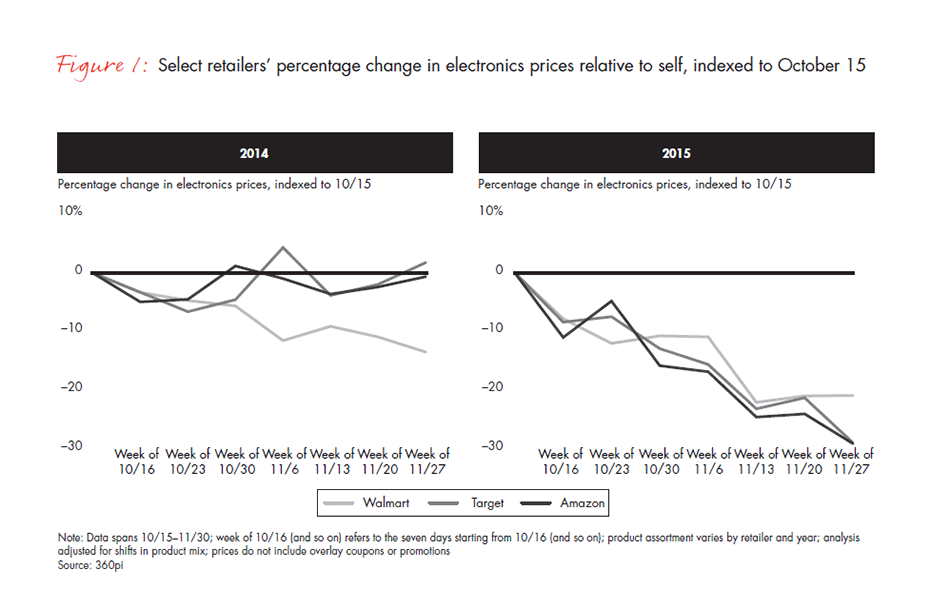
Retailers explored new ways to make shopping fun
To take some of the stress out of Thanksgiving weekend shopping this year, retailers beefed up promotional merchandise to ensure that their best deals were available to shoppers. JCPenney, for example, filled its shelves with top-selling items, including small kitchen appliances, consumer electronics, sheets, towels and boots, hoping to avoid last year’s stock-outs. Walmart enlisted the help of 3,600 Santas to ramp up the holiday cheer in its stores. Macy’s updated its mobile app to guide shoppers through the store and provide real-time product recommendations. Users could swipe—Tinder style—to make purchases directly from their mobile devices.
We asked our Vision Critical panelists to recount their most memorable shopping experiences over the weekend. Some described the blankets American Eagle handed out to those waiting in line outside the store. Inside Best Buy, some appreciated the extra staff on hand to help answer questions and carry heavy items to the counter. Shoppers also praised the organization they found in stores this year, particularly clearly marked maps and ticket numbers for doorbusters. Above all, our panelists appreciated the festive atmosphere retailers created, complete with holiday music and decorations. To ensure the whimsical was not lost this holiday season, Barneys, for example, transformed the windows of its Manhattan flagship store into a winter wonderland, complete with a functioning 35-foot ice locker.
All eyes on Amazon this holiday season
Amazon saw record sales over the five-day shopping weekend—not surprising considering that their third-quarter net sales in the United States were up nearly 30% over last year and that the company has similar expectations for the fourth quarter.
At least part of that increase can be attributed to Amazon Prime, which the company introduced 10 years ago. One in four American households now has access to an Amazon Prime membership. Amazon signed up 10 million new Prime accounts last holiday season and today boasts an American membership base of close to 45 million.
And Amazon continues to innovate. In October, the company launched Handmade at Amazon, a marketplace for handcrafted products, to compete head to head with rival Etsy. In an ironic twist harking back to its origins as an online bookseller, Amazon opened a physical bookstore in Seattle this fall, leveraging online data to inform the in-store assortment and prices. It also unveiled a crowdsourced one-hour package delivery service, Amazon Flex, which should be operating soon in nine markets. Amazon is quick to test new concepts, but not every test is successful. The company recently announced plans to shutter two businesses: Amazon Local, its daily deals platform, and Amazon Destinations, its nascent hotel booking service.
The Amazon flywheel keeps turning
Amazon fuels its growth by linking three offerings: a broad and relevant assortment, an extraordinary customer experience and attractive prices. The rationale: A vast and growing selection of products means that customers are more likely to find what they’re looking for. And when the shopping experience—from search to fulfillment—is a positive one and when prices are consistently competitive, customers come back for more. This traffic encourages third-party sellers to get on board, further broadening selection.
Earth’s biggest selection. Amazon.com sells an astounding 365 million products across 19 major categories, a selection enabled by its marketplace structure. Today, more than 50% of products on the website are from third-party sellers. And in the last two years, the volume of third-party goods has doubled. Third-party sellers not only expand the product assortment available with minimal financial risk, they also function as a test bed for Amazon’s first-party business, allowing it to cherry-pick which profitable and fast-moving inventory it brings in-house to sell directly. As Amazon broadens its selection, it also raises barriers to competition: Today, almost 50% of online consumers in the United States start their online shopping at Amazon, up from 30% just three years ago.
In an effort to compete with Amazon’s assortment of products, some retailers are operating their own online marketplaces. Sears Marketplace has been competing head to head with Amazon since its inception nearly six years ago. Although Sears claims it is the third largest online mass merchant in the United States, with 15 million unique visitors a month, its marketplace continues to represent a relatively small percentage of total sales. Taking share from Amazon is no easy feat. Best Buy uses a slightly different approach: It carefully controls its third-party offerings to fill gaps in assortment, avoid competition with its own merchandise, and enhance the customer experience. Best Buy sells products from select third-party merchants and processes orders through a partnership with Rakuten, Japan’s largest e commerce company. Sellers must sell on Rakuten.com (the company’s US website), be able to ship items within two business days and offer a 30-day return or exchange policy.
Why is the marketplace concept appealing to retailers? In large part because marketplaces generate traffic (through online searches) and attractive margins. A key challenge for retailers considering a marketplace is the difficulty of closing the huge competitive gap in a game that Amazon plays so well. Moreover, the investment needed to support the marketplace platform is significant, and few can match the benefits Amazon extends to its vendors. The marketplace concept also introduces complexity, both for the consumer—searching and finding the right items—and for the retailer—managing "conflicts" with first-party merchandise and handling returns and guarantees. Finally, because retailers have less control over products posted for sale by independent third parties, their reputation may suffer. Sears has come under fire several times for selling offensive items on its marketplace. Given its more traditional brand name, it faces greater scrutiny than Amazon does even though Amazon may carry identical merchandise.
Best-in-class customer experience. Amazon has a Net Promoter Score® (NPS®) of 58%, nearly four times that of Etsy, the next best marketplace and 7 points higher than Nordstrom, the omnichannel retail market leader in customer loyalty.4 To provide the best customer experience—while still offering Earth’s biggest selection—Amazon created Fulfillment by Amazon (FBA). Third-party vendors store their merchandise at Amazon warehouses, and Amazon takes care of picking, packing, shipping and providing customer service for the products sold. More third-party vendors are using FBA than ever before: The gross merchandise value (GMV) of FBA goods increased from 20% of Amazon’s global sales in 2011 to nearly 40% last year. With FBA, third-party sellers not only outsource fulfillment, they also gain access to Amazon’s expanding base of Prime members and the opportunity to be featured in Amazon’s Buy Box. The Buy Box drives more than 80% of sales on Amazon.com. In exchange, Amazon is able to control the quality of packaging, the speed and cost of shipping, and all customer touchpoints.5
To maintain this control, the economics of FBA are designed to attract vendors, at least in the near term. Amazon takes an average of 8% to 15% of every third-party sale. On top of this, Amazon charges additional FBA service fees for storing, picking and handling that vary based on product size and weight, inventory turns, special packaging and returns processing. Our proprietary analysis of Amazon’s global financials suggests that for a $100 gift sold on the site this holiday season, Amazon nets roughly $5 if the gift is a third-party non-FBA item, and close to $0 if it is a third-party FBA item (or a first-party order) (see Figure 2). Over the longer-term, Amazon is working to do two things: continue to bring attractive FBA products in-house to enhance margins and its strategic offerings, and make it impossible for vendors to compete on their own, given Amazon’s fulfillment network and access to Prime customers. As Amazon gets the upper hand, third-party take rates are likely to increase.
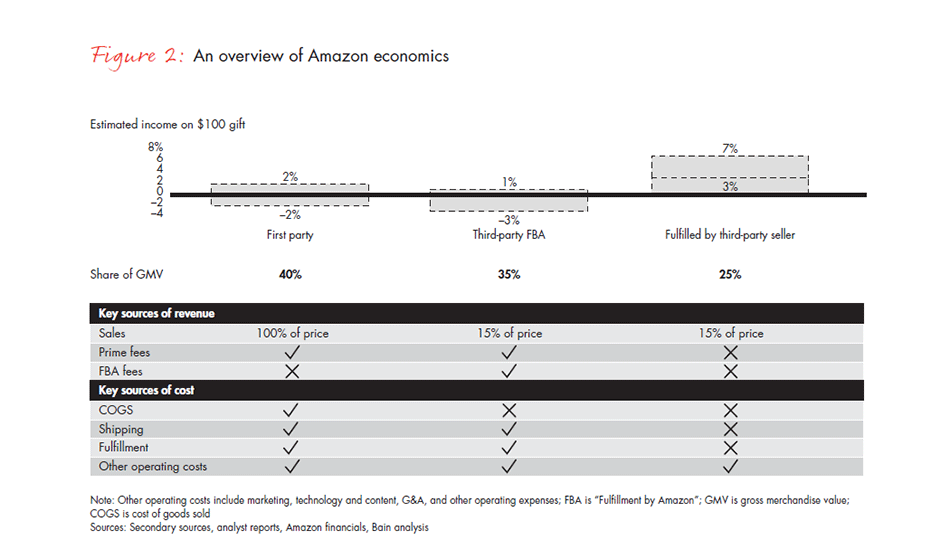
Lower prices. More than 40% of our Vision Critical panelists said they would spend more on Amazon.com this holiday season than they did last year. The reason they cited most often: lower prices. The common perception is that Amazon competes aggressively with other retailers on price. To test that perception and reality, we did our own research. We uncovered three interesting findings:
- Holiday shoppers believe Walmart offers the lowest prices. Bain partnered with Pollbuzzer/ROI Rocket to ask 1,000 shoppers to share their perceptions of price across product categories and major retailers.6 We found that a majority of consumers feel that Walmart offers the lowest prices, significantly lower than Amazon in televisions, small appliances and toys (see Figure 3).
- Amazon is better at converting winning price perception into sales. While more consumers perceive Walmart has the lowest prices, Amazon is winning on conversion. For example, more than 70% of the shoppers who think Amazon offers the lowest price on tablets will buy a tablet from Amazon this holiday season. In contrast, Walmart’s conversion rate is just 45%. And almost 20% of shoppers who believe Walmart offers the lowest price on tablets told us they will actually purchase a tablet from Amazon. Why? Many shoppers trust Amazon’s prices to be competitive, and they are willing to forgo an incremental discount in exchange for convenience and peace of mind. Walmart holds true to its promise of everyday low prices, but it’s clear that price is not consumers’ sole criterion for purchase.
- Although it generally delivers on lower prices, Amazon does not always offer the lowest prices. Actual pricing data this holiday season confirm that Amazon is not the lowest-priced provider the majority of the time; instead, the company appears to be the fastest follower to the lowest-priced competitor, particularly on high-velocity products. Together with 360pi, we compared actual price points across several categories and retailers this holiday season (see Figure 4). In a sample of more than 12,000 online products, Amazon offered the lowest price about 30% of the time (excluding shipping fees and overlay coupons); it matched other retailers’ lowest price another 40% of the time. Amazon was much more aggressive on its best sellers, however, offering or matching the lowest price on about 90% of items this holiday season.
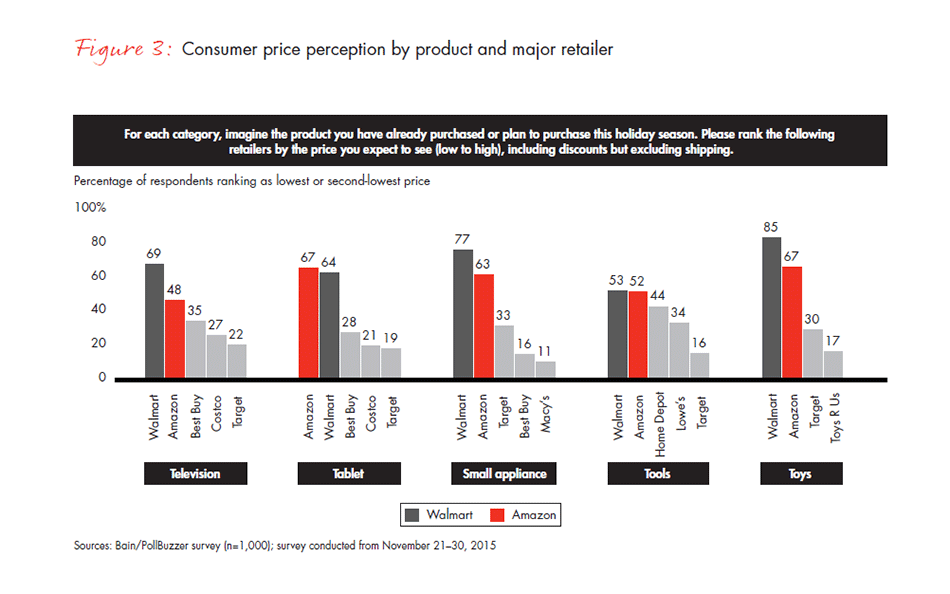
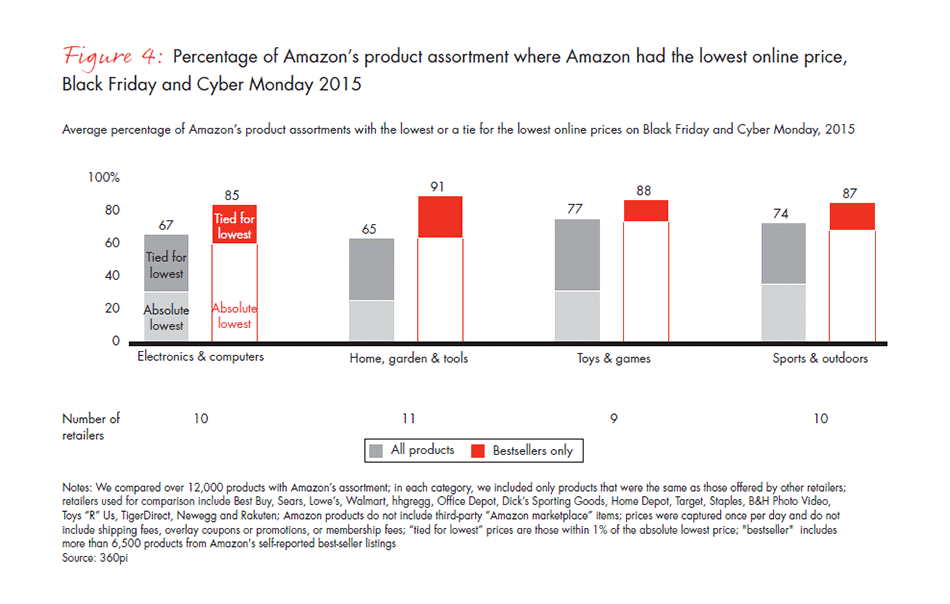
Amazon is constantly looking to maximize margin via dynamic pricing. The company employs dynamic-pricing algorithms to auto-adjust prices based on competitors’ prices, consumers’ price sensitivity, inventory levels and handling requirements for specific products. Algorithms change prices an estimated five times a day, and prices can fluctuate 20% to 30% in any 24-hour period. Amazon is expected to make 10 billion price changes this holiday season.
Other retailers have followed suit. Walmart, Best Buy and Staples are using dynamic pricing to compete more aggressively on price and to optimize their online margin. But dynamic pricing can be challenging for omnichannel retailers striving for pricing congruency across channels. In 2012, Kohl’s deployed Altierre electronic price displays to its more than 1,100 stores to address this issue. Although the displays allowed the retailer to change prices quickly, the solution was not perfect: It’s expensive—outfitting a single store can top six figures—and changing in-store prices multiple times a day can confuse and frustrate customers. Other retailers that have tested electronic displays to date include The Home Depot and Sears.
Dynamic pricing may be less useful for more unique retailers. For example, in an effort to eliminate the hassle for customers of submitting a price match request, Nordstrom now trolls the Internet for select products and automatically matches prices that are lower. Shoppers on Nordstrom.com can search the term "price matched" for a list of these discounted products. It’s too early to evaluate the success of the program; but given that Nordstrom’s best customers typically purchase at full price, automatic price matching not only cedes margin dollars but may also be training the company’s best customers to become more promotional shoppers.
The Prime advantage
Today, sales from Amazon Prime members represent roughly 35% to 40% of Amazon’s global GMV, and the push to attract more Prime members continues. Prime Day 2015 acquired a record-breaking number of new accounts leading into the holiday season and nearly 20% more sales than Black Friday brought in last year. With Prime subscriptions projected to grow by 15% to 20% a year, Bain expects sales from Prime users to grow to as much as 65% of GMV by 2020. Amazon is counting on this growth to make the economics more attractive for its first-party and FBA businesses, a gamble no other retailer can afford.
On average, customers spend 40% more after becoming Prime members and are five to six times more likely to convert a search on Amazon.com to a sale. Although the costs associated with accelerated fulfillment services may outweigh this upside today, Amazon is banking on members becoming even more loyal, buying even more and willingly paying higher fees as the benefits of membership expand, and thus over time becoming much more valuable than their non-Prime counterparts. Not surprisingly, then, Amazon continues to invest in its Prime customer franchise, expanding eligible assortment through category extensions, optimizing the fulfillment experience with new warehouses and technology, and providing access to new services, including media, digital storage and AmazonFresh.
Customers are already willing to pay more for Prime. In 2014, subscriptions grew by 60% despite a 25% increase in the annual fee. About 40% of our Vision Critical panelists who use Prime said that they would pay more than the current $99 a year, with several suggesting they would pay up to $150 a year. Although customers overwhelmingly join Prime for access to two-day shipping, members appear to be taking advantage of the added benefits. More than 60% of the Prime members in our Vision Critical panel report having used Prime Video, and 50% have used Prime Music offerings. Of those using Prime Video, more than 30% do so at least weekly (see Figure 5).
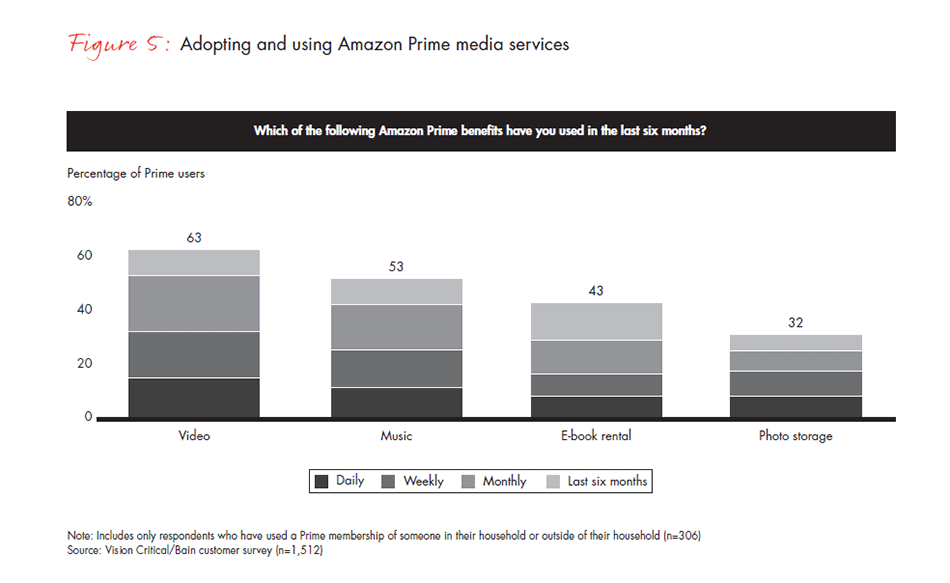
One study suggests that Prime Video is now the second most prevalent subscription video-streaming service in America after Netflix, with double the number of households subscribing to Hulu.
Not only is Amazon offering more benefits to Prime members; it is also tailoring benefits to members’ preferences. For example, Amazon offers Prime members a $1 Prime Video credit or $5.99 toward a Prime Pantry purchase in exchange for choosing a slower shipping option. More than 60% of the Prime members on our Vision Critical panel said they accepted that offer at least once in the last year, and more than half said they take advantage whenever the option is available.
How are other retailers responding to Prime? This summer, Walmart began testing its own subscription model, ShippingPass, inviting customers in select markets to enroll in a $50 "free" three-day shipping program. Although ShippingPass is half the cost of Prime, Walmart is facing some headwinds. First, its customer base is lower income, so a subscription service may not be as attractive a proposition. Second, many of those that may be interested are already Prime members, which means they’re already enjoying two-day shipping plus all of the other Prime benefits. In another attempt to uproot Amazon, Jet launched its shopping site this summer, advertising prices as much as 15% below Amazon’s. Jet offered an introductory $50 membership fee but quickly abandoned it in its struggle to develop a user base.
Retailers with a more differentiated offer may find the path to a profitable subscription business easier. Wine. com, for example, one of the largest online wine retailers in the United States, offers “free” shipping with a $49 annual membership fee to its StewardShip program. Members spend on average 30% more per order and five times more per year than nonmembers do. The subscription model has been successful because of its unique value proposition. Despite several attempts to compete in wine, Amazon refuses to offer wineries FBA services or to purchase inventory directly, largely a function of legal constraints. As a result, wine is not Prime-eligible. Consumers like the value proposition of Prime, however, and in this case they have gone elsewhere to get it. storage, fulfillment and shipping, which both appeals to boutique wineries and delivers a superior experience to customers.
Finding elements of value to compete with Amazon
Amazon gives its customers utility: It saves shoppers time and effort, simplifies the process and helps them avoid hassles, offers variety and quality, and reduces cost. In addition, Amazon Prime members are increasingly finding value in access to the "free" assortment of videos, music and digital books now available to them.
Although value propositions are often thought to be a simple trade-off between quality and price, they’re not. Bain research suggests there are many more ways to satisfy customers. In fact, to date we’ve identified 30 elements of value that can lift products and services above commodity status. They range from functional benefits— reducing effort or saving time, for example—to more emotional benefits, including reducing anxiety and increasing affiliation, motivation, nostalgia and fun (see Figure 6).
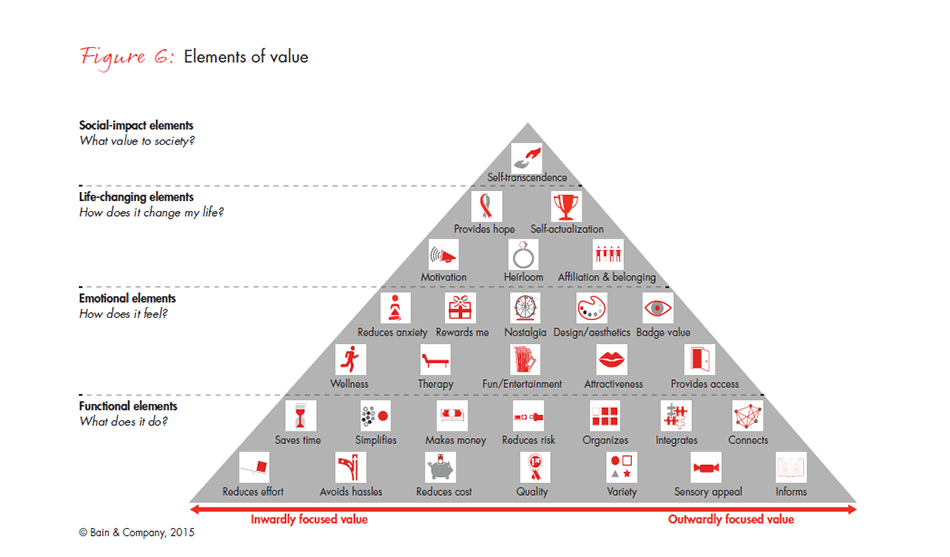
This year, Bain partnered with Research Now to survey more than 8,000 current customers of nearly 50 US companies to better understand these sources of value.7 We found that Amazon and other companies with very strong value propositions deliver multiple elements of value and, in turn, generate higher Net Promoter Scores and revenue growth. Interestingly, while online-only retailers spike on more functional elements, they fail to differentiate on more emotional elements—and that’s where omnichannel retailers can win this holiday season. Our survey results indicate that omnichannel websites are twice as likely as online pure plays to deliver significant value to consumers on the following elements: represents who I am, makes me feel attractive, appeals to my senses, is good for my physical or mental well-being, helps me to help others and helps me feel part of a group. Moreover, companies with more emotional elements tend to have an even higher NPS. We found that companies with three or more functional elements earned an NPS of 40% and that companies with three or more emotional elements earned an NPS of close to 65%.
Although Amazon has deliberately added elements of value over time (Prime and enhancements to Prime are examples), it still has plenty of room to add emotional value. Getting consumers to think of Amazon as a go-to destination for more emotional categories has been challenging for the retailer. This holiday season, online shoppers are most likely to shop on Amazon.com for more transactional categories like books and magazines, toys and electronics. They are least likely to turn to Amazon for more emotional or sensory purchases—clothing and accessories, jewelry and home items.8 For example, despite the thousands of labels on offer, Amazon Fashion is gaining momentum very slowly. Amazon must navigate an industry with greater unpredictability and offer shoppers not only convenience, variety and price, but also an experience.
To learn more about Bain’s research on elements of value, please email us at capabilities@bain.com.
Retailers can strengthen their value propositions to compete with Amazon in several ways:
- Offer exclusivity: Offer exclusive products and brands that appeal to your best customers versus unprofi table Black Friday shoppers. Disproportionately focus marketing on these offerings, which are safe from price competition.
- Price strategically: Understand your key item and category roles and relative cost position so that you can be more strategic about where you do and do not compete on price.
- Innovate in stores: Find ways to innovate and leverage stores as a key point of differentiation. Develop omnichannel fulfillment capabilities to (1) remain competitive on free and fast delivery and (2) beat Amazon with free same-day pickup in all markets.
- Develop personal relationships: Build real customer loyalty across the elements that are unique to you, including in-store services, community events and exclusive access. The majority of purchases and purchase history still sit with offline and omnichannel retailers. And stores have associates who can develop live personal relationships with shoppers. Winning retailers will amplify both of these advantages over pure-play e-tailers.
- Appeal to emotion: Appeal to the hard-to-break-through emotional elements—to nostalgia, affiliation, design and attractiveness, and fun, to name a few—that both fit with your brand and capabilities and fill a consumer need. Win with curation and inspiration, not just listings.
Having the right strategy is only half the equation, however. Often the biggest difference between leaders and laggards is the effectiveness with which organizations deliver on those strategies. Winning retailers focus on hiring and retaining superior talent, creating agile innovation cultures and fueling capabilities with investments in technology and analytics.
Future release dates and topics
In our next issue, we examine the role of stores this season and innovative ways retailers are blending the best of digital and physical shopping into a Digical® experience. We also review the latest holiday sales results, including November’s register tallies. Here’s the breakdown of the last two issues:
- Issue #4 (mid-December): Digical® retail and why stores matter
- Issue #5 (late January): Holiday recap and 2016 outlook
Darrell Rigby is a partner in Bain & Company's Boston office and leads the firm's Global Retail and Global Innovation practices. Erika Serow, a partner in Bain's New York office, leads the Retail practice in the Americas. Suzanne Tager is a senior director with Bain's Retail practice in New York. Aaron Cheris is a partner in Bain's San Francisco office, and leads the Customer Strategy & Marketing practice in the Americas. Eric Almquist is a Boston-based partner with the firm's Customer Strategy & Marketing practice.
View the PDF for a list of references
1 Quad Analytix provides retailers with market intelligence to inform their business decisions. According to the company, it captures and analyzes product, pricing, placement and promotion data from hundreds of retailers and presents the information in an easy-to-use software-as-a-service application.
2 Vision Critical provides a cloud-based customer intelligence platform that allows companies to build engaged secure communities of customers they can use continuously, across the enterprise, for ongoing real-time feedback and insight. Vision Critical’s Consumer, Retail, & Shopper Insights Consulting Practice uses its proprietary national community, Springboard America, to provide longitudinal insight on consumers’ holiday shopping journey. Vision Critical surveyed 1,500 consumers representative of the general US population between November 6 and 10 and November 29 and December 1 using an interactive online survey.
3 A pricing analytics company, 360pi helps retailers and brands make smarter pricing decisions. According to the company, it works with top retailers to enable them to “gain real-time visibility into the market, full awareness of the competitive pricing landscape and the ability to ‘right-price’ to shoppers, which often leads to revenue uplift and higher margins.”
4 The NPS is derived from a survey that asks consumers, “On a scale of zero to 10, how likely would you be to recommend this company (or this product) to friends and colleagues?” Ratings of 9 or 10 indicate promoters; 7 and 8, passives; and zero through 6, detractors. The score is simply the percentage of promoters minus the percentage of detractors. In two Bain surveys, 1,897 consumers shared their views on Amazon and 3,882 consumers rated major department stores.
5 To learn more about Amazon’s supply chain capabilities, see Retail holiday newsletter #2: 'Tis the season for free shipping.
6 PollBuzzer and ROI Rocket jointly provide full-service primary research solutions to clients in the management consulting and private equity industries, among others. Combining decades of industry-leading experience in research science, panel building and respondent recruitment, with consulting veterans’ knowledge of the unique challenges faced by investors and corporations and their advisors, PollBuzzer and ROI Rocket are particularly well positioned to be thought partners regarding all manner of research and marketing issues. This survey was conducted between November 21 and November 30. Respondents were asked to rank retailers from lowest price to highest price (including discounts but excluding shipping) for a television, small appliance, tablet, tool or toy that they had already purchased or plan to purchase this holiday season. For details, contact Noah Seton (noah@pollbuzzer.com) or Tim Wilson (tim.wilson@roirocket.com).
7 Research Now is a leader in digital data collection to power analytics and insights. The company helps clients interact with the world’s consumers and business professionals through its online panels as well as its mobile, digital and social media technologies. Research Now worked with Bain & Company to survey consumers for Bain’s elements of value research.
8 Vision Critical surveyed 1,500 consumers representative of the general US population between November 6 and 10, and November 29 and December 1 using an interactive online survey.
Digical® is a registered trademark of Bain & Company, Inc.
Net Promoter® and NPS® are registered trademarks of Bain & Company, Inc., Fred Reichheld and Satmetrix Systems, Inc.





